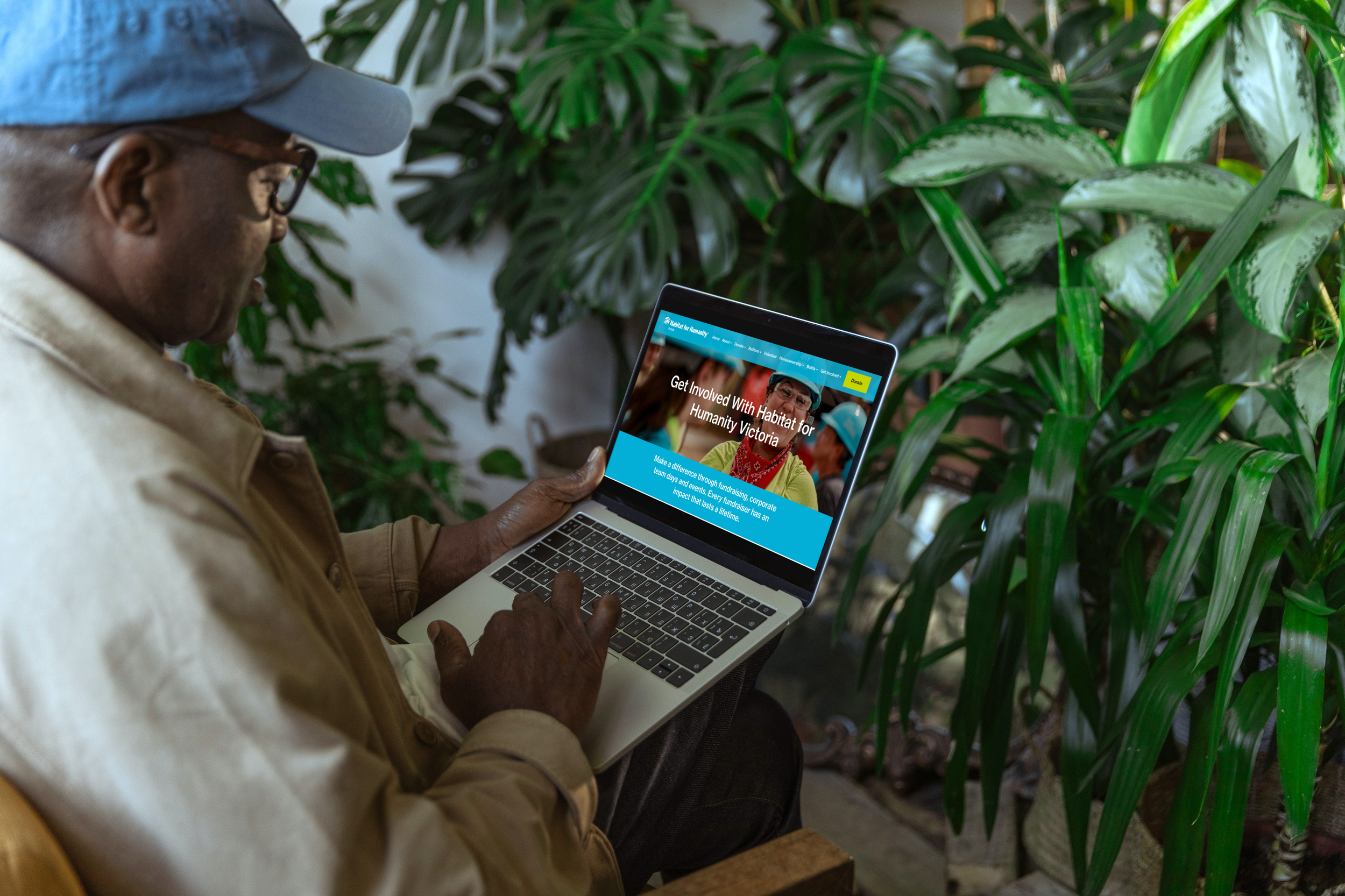How AI and No Code Tools Can Finally Bridge the Gap for Nonprofit Marketing and Design
Every day, nonprofits and purpose-driven brands are creating ripple effects that change lives. They are feeding families, protecting wildlife, driving policy work, advancing human rights, or building stronger communities. This work has depth, purpose, and measurable impact that would inspire anyone who truly understood it.
But too often, their marketing and design fails to tell the story that allows this transformative work to shine.
If you've ever looked at your website and online presence and felt frustrated that it doesn't capture the magnitude of your mission, you're not alone. Most nonprofit leaders share this painful disconnect between the transformative work happening in the field and the lackluster digital experience they're able to offer supporters.
The good news? No code tools and an AI are helping level the playing field and make it possible for nonprofits to create digital experiences that are as compelling and impactful as the work they do every day. And the organizations that embrace this technology aren't just improving their marketing, they're ensuring their vital missions reach the people who need them most.
No code and low code tools are helping to remove the technical limitations that have left so many profits slow to embrace costly digital transformation. Now nonprofits can build on platforms like Webflow, Framer and Squarespace, integrate donation platforms like Canada helps and lean into AI automation.
The Current State of AI in Nonprofit Marketing
Nonprofits are often tasked and doing more with less, so it is no surprise that AI can help fill gaps where budgets aren’t available.
Recent industry surveys reveal that the vast majority of nonprofits are actively exploring AI tools, number that reflects the sector's hunger for solutions that can amplify their impact. However, there's a significant gap between exploration and execution: most organizations haven't developed formal AI strategies, and while nearly all nonprofits believe AI will improve their efficiency, far fewer are using it effectively in their day-to-day operations.
This gap isn't about lack of interest or capability. It's about the same resource constraints that keep your website from reflecting your true impact. The nonprofits breaking through this barrier aren't necessarily the ones with bigger budgets, they're the ones approaching AI strategically, focusing on tools that solve their most pressing marketing and communication challenges.
Why This Matters More Than You Think
Research consistently shows that larger nonprofits with substantial budgets are adopting AI at significantly higher rates than smaller organizations. This isn't just about having bigger tech budgets, it's about having the digital infrastructure to tell their stories effectively, reach the right donors, and create the kind of online experiences that inspire action.
The organizations that figure out AI-powered marketing and web design first won't just raise more money. They'll be able to advocate more effectively, reach more people who need their services, and build the kind of supporter communities that sustain long-term impact.
Your mission is too important to be held back by a digital presence that doesn't do it justice.
The Opportunity Gap in Strategic Implementation
Real-world data is starting to show the impact of AI implementation in nonprofit fundraising. Organizations using mature AI systems have experienced an 85% increase in response rate and a 20% increase in average gift size. Additionally, 30% of nonprofits report that AI has boosted fundraising revenue.
Perhaps most encouraging for organizations considering AI adoption: the more generous the donor, the more likely they are to support nonprofits using AI—30% for high donors, 19% for medium donors, and 13% for small donors. This suggests that embracing AI isn't just about improving internal processes; it's about attracting the kind of long-term, high-value supporters that sustain organizational growth.
These early adopters are discovering that AI isn't just a productivity tool, it's becoming a competitive advantage in an increasingly crowded charitable landscape.
How AI Search Presents a Strategic Opportunity for Nonprofits
The Emerging Trend in Information Seeking
The data tells a compelling story about how people are beginning to interact with information. AI-powered search and information retrieval is growing exponentially, fundamentally changing how people research topics that matter to them. Search behaviour is evolving rapidly, with more queries being answered directly through AI-generated responses rather than traditional click-through results.
This shift creates an unprecedented opportunity for nonprofits to be discovered by potential supporters who are asking AI assistants questions like:
"What are the most effective climate change organizations?"
"How can I find local nonprofits that help homeless families?"
"Which charities have the lowest administrative costs?"
The trajectory is clear: AI will continue to evolve and reshape how we seek and consume information, moving beyond traditional search engines to more integrated, conversational, and personalized experiences.
Rethinking How You Share Your Impact
Here's where the strategic opportunity becomes practical: How you format and present your organizational information directly impacts AI visibility. Traditional annual reports served as downloadable PDFs are essentially invisible to AI systems that can't easily parse and cite complex document formats.
Smart Content Strategy for AI Visibility:
Transform annual reports into web pages with clear headings, statistics, and narrative sections that AI can easily reference
Create impact summaries with concrete data points and success stories in accessible formats
Develop FAQ sections that directly answer common questions donors might ask AI assistants
Use structured data markup to help AI systems understand your organization's key information
Nonprofit landing page showcasing impact and CTA for donation
Emerging Content Formats: While traditional annual reports serve important stakeholder needs, consider creating parallel content that's optimized for discovery:
Impact landing pages that break down annual report data into digestible, citeable sections
Story-driven case studies that demonstrate your work's real-world impact
Data dashboards that showcase your metrics in formats AI can easily interpret and reference
This strategy is about making your impact data more discoverable and shareable in an AI-driven information landscape.
Nonprofit Stylized Annual Report
5 Critical Nonprofit Marketing Challenges AI Can Solve
1. Content Hierarchy and Information Architecture That Confuses Donors
The Problem: Most nonprofit websites often fall into two extremes. Either they're sparse and fail to share compelling information about their impact, or they're overwhelming with content but can't extract the key information that matters to donors, search engines, and AI systems. Visitors can't quickly understand what the organization does, why it matters, or how they can help.
The AI Solution: AI can analyze your existing content and user behaviour (analytics, heatmap data) to recommend optimal information architecture. It can identify which stories and data points resonate most with donors, suggest content hierarchy improvements, and help prioritize what information appears prominently. AI tools can also audit your content for clarity, ensuring your most compelling impact stories and clearest calls-to-action get the visibility they deserve.
2. Generic Design and Storytelling That Fails to Connect
The Problem: When you work on a mission day in and day out, it's easy to forget that potential supporters may be learning about your cause for the first time. They don't have your context, your deep understanding, or your emotional investment just yet. This familiarity gap often leads to generic storytelling, bland marketing materials, and web design that assumes too much knowledge while inspiring too little action.
Your potential donors need an insider's lens into why this work matters. They need to see themselves reflected in your cause and feel the same excitement you experience daily. But too often, nonprofit marketing speaks in insider language, uses stock imagery that could represent any cause, and fails to create the aesthetic and emotional connections that transform casual visitors into passionate champions. Generic mission statements and one-size-fits-all messaging can't compete with organizations that truly understand their audience's motivations, visual preferences, and emotional triggers.
3. Ineffective Calls-to-Action
The Problem: Many nonprofits struggle with CTA buttons that blend into their website design or use language that doesn't motivate action. Poor CTA design directly impacts donation conversion rates. Using the Jobs to be Done framework is a helpful tool to understand what different audience segments are trying to accomplish and craft corresponding content and CTA’s that meet them where they are.
4. Complicated Volunteer Signup and Onboarding
The Problem: Complicated sign-up forms and poor email marketing management make it difficult to recruit and retain volunteers effectively.
Volunteer recruitment isn't just about getting people to sign up once, it's about creating a seamless journey from initial interest to long-term commitment. When someone visits your website excited to help, a confusing 12-field volunteer form can kill that enthusiasm instantly. They might abandon the process entirely, or worse, complete it but feel frustrated from the start.
Why This Compounds:
Poor initial experiences set the wrong tone for the entire volunteer relationship. If someone struggles to sign up, they're already questioning the organization's competence before they've even started volunteering. Then, if they receive generic, poorly-timed follow-up emails (or no follow-up at all), that initial doubt gets reinforced.
The User Experience Connection:
The best volunteer programs understand that recruiting is really about designing an experience that makes people feel valued and capable from the first click. This means:
Intuitive web flows that guide people naturally from "I want to help" to "I'm actively helping"
Smart form design that collects only essential information upfront and saves detailed questions for after someone is engaged
Personalized email sequences that acknowledge different volunteer interests, availability, and skill levels
Clear next steps at every stage so volunteers never wonder "what happens now?"
The Retention Factor:
Most nonprofits focus on recruitment but ignore retention design. A volunteer who has a smooth onboarding experience, receives relevant communications, and feels connected to the mission through thoughtful touchpoints is exponentially more likely to become a long-term supporter and even a donor.
5. Mobile Donation Experience Optimization
The Problem: With increasing numbers of donors giving via mobile devices, nonprofits need mobile-optimized donation experiences that work seamlessly across all devices.
Mobile giving is about understanding how people make giving decisions differently when they're on mobile devices. Mobile donors are often giving impulsively, inspired by a social media post or news story they just read. They want to act on that emotional moment immediately, but if your donation process requires multiple page loads, complex form fields, or forces them to create an account, you've lost them.
Why This is Critical:
Online giving continues to grow, with more donors giving on the go than ever before. We know that recurring donors give 42% more annually than one-time donors, and that frictionless experiences dramatically improve conversion rates. However, most nonprofit websites were designed for desktop users who might research extensively before giving.
The User Experience Connection:
Effective mobile donation design means rethinking the entire giving journey:
One-thumb navigation where users can complete the entire process without stretching their fingers across the screen
Minimal form fields that use smart defaults and auto-fill capabilities
Trust signals prominently displayed since mobile users can't easily open new tabs to verify your legitimacy
Payment options that match mobile behavior (Apple Pay, Google Pay, saved payment methods)
Immediate confirmation and emotional payoff so donors feel good about their decision instantly
The Retention Factor:
A donor who has a smooth mobile giving experience is more likely to give again, share your cause with friends, and potentially convert to recurring giving. But a frustrated mobile donor doesn't just abandon their current donation, they often form a lasting negative impression that prevents future engagement entirely. A poor mobile experience might suggest that the nonprofit, however worthy their cause, is lacking organization and efficiency and therefore they feel like their money won’t be put to good use.
Implementing AI in Your Nonprofit Marketing Strategy
Start Small, Think Big
You don't need a massive budget or technical team to begin leveraging AI in your nonprofit marketing. Here's a practical roadmap:
Phase 1: Content Optimization (Months 1-2)
Implement AI writing assistants for social media and email marketing
Use AI tools to optimize existing website content for search engines and AI assistants
Create FAQ sections that address common donor research questions
Phase 2: Donor Intelligence (Months 3-4)
Implement AI-powered analytics to better understand donor behavior
Begin personalizing email campaigns based on AI-generated donor insights
Optimize donation page elements using AI-driven A/B testing
Phase 3: Advanced Automation (Months 5-6)
Deploy chatbots for donor support and volunteer coordination
Implement predictive analytics for donor retention and major gift identification
Create AI-optimized content calendars that maximize engagement
Measuring Success: Key AI Marketing Metrics for Nonprofits
To ensure your AI implementation delivers results, focus on these critical metrics:
Donation Conversion Rates: Track improvements in online giving completion
Donor Acquisition Cost: Measure how AI reduces the cost of acquiring new donors
Email Engagement Rates: Monitor improvements in open rates and click-through rates
Website Session Duration: Assess how AI-optimized content keeps visitors engaged
AI Search Visibility: Track appearances in AI search for relevant queries
The Future Balance: AI Integration and Brand Recognition
For nonprofits, the future will require balancing digital transformation through AI with strong brand recognition. This balance is crucial because success in the nonprofit sector depends not just on efficiency, but on trust, emotional connection, and sustained relationships.
Understanding Brand Awareness in the Nonprofit Context
Brand awareness for nonprofits goes beyond simple name recognition. It encompasses:
Mission Clarity: How quickly people understand what you do and why it matters
Trust Indicators: Reputation for transparency, effectiveness, and ethical operations
Emotional Connection: The feelings and associations people have with your cause
Recall and Recognition: Whether people think of your organization when relevant issues arise
How Brand Awareness Drives Results
Research consistently shows that strong nonprofit brands achieve better fundraising outcomes by increasing visibility and generating deeper supporter engagement. When people recognize and trust your organization:
Donation conversion rates improve because trust reduces friction in the giving process
Volunteer recruitment becomes easier as your reputation precedes formal outreach
Word-of-mouth referrals increase when supporters can easily explain and recommend your work
Media and partnership opportunities expand as your brand becomes synonymous with expertise in your cause area
Brand Consistency Across All Touchpoints
Your brand is shaped by every interaction someone has with your organization:
Web Design: Visual consistency, user experience, and accessibility communicate professionalism and values
Usability: How easy it is to donate, volunteer, or access information reflects your respect for supporters' time
Marketing Messaging: Consistent voice, tone, and value propositions build recognition and trust
Digital Experiences: From email design to social media presence, every touchpoint reinforces or undermines brand perception
Why Nonprofit Marketing Messaging Is Mission-Critical
Marketing messaging for nonprofits carries unique weight. Rather than selling features, it is about translating complex social issues into compelling calls to action. Effective nonprofit messaging must:
Bridge Understanding Gaps: Most people don't fully grasp the complexity of social issues. Your messaging must educate while inspiring, providing enough context for informed action without overwhelming potential supporters.
Create Emotional Connection: Unlike commercial marketing, nonprofit messaging must connect hearts and minds. People give to causes they feel emotionally invested in, but they also need logical reasons to trust their investment will create change.
Demonstrate Impact: Donors want to see their contributions make a difference. Your messaging must clearly connect their potential gift to tangible outcomes, using specific examples and measurable results.
Maintain Authenticity: In an era of information overload, authenticity cuts through noise. Your messaging must reflect your organization's genuine voice and values, not follow generic nonprofit templates.
Inspire Action: Every piece of marketing messaging should move people toward deeper engagement, whether that's making a first donation, increasing their giving, volunteering, or becoming advocates for your cause.
Building AI-Ready Nonprofit Infrastructure
Success with AI marketing requires more than just implementing tools. It requires building organizational capacity for ongoing digital innovation. This includes:
Staff Training: Ensuring your team understands how to leverage AI tools effectively while maintaining your organization's authentic voice.
Data Quality: AI tools are only as good as the data they work with. Invest in clean, organized donor and program data.
Strategic Integration: AI should support your overall marketing strategy, not replace strategic thinking about your mission and donor relationships.
Conclusion: Your Next Steps
The evidence is clear: AI is transforming nonprofit marketing, and organizations that embrace this technology are seeing measurable improvements in fundraising, donor engagement, and operational efficiency. The question isn't whether your nonprofit should explore AI—it's how quickly you can begin implementing solutions that align with your mission and budget.
Remember, the most generous donors are already showing preference for nonprofits that leverage AI effectively. By optimizing your organization for AI visibility and implementing smart automation tools, you are helping position your nonprofit to attract the high-value, committed donors who will sustain your mission for years to come.
The AI revolution in nonprofit marketing has begun. The organizations that act now will lead the sector into its digital future, while those that wait may find themselves struggling to catch up in an increasingly competitive landscape.
Ready to transform your nonprofit's marketing with AI? The time to start is now, and the potential for impact has never been greater.
Looking for expert guidance on implementing AI marketing strategies for your nonprofit? Contact our team to learn how we can help your organization leverage these powerful tools while staying true to your mission.












